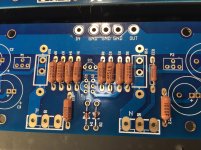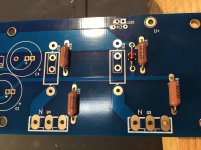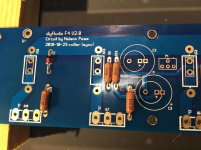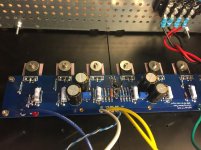So if I understand correctly, there is no way to get more power from F4 with single ended inputs, because monoblock configuration will just give me more current capabilities right?
I'm listening to F4 paired with Ale Moglia's 01A SIC biased pre for a few days now and I'm totally delighted.
This combination has all the pros of DHT and all the hard work is perfectly done by F4.
What will be best option to get more power from this setup? Some kind slightly step-up balancing transformer?
Right now I'm totally satisfied by spl I get from my Alpairs 7.3. But I'm about to move to bigger place in near future, so more power might be needed.
From the manual (http://www.firstwatt.com/pdf/prod_f4_man.pdf)
"The amplifier can be run in three configurations. There is one way to use the amplifier in stereo. There are two ways you can run the amplifier as a monoblock, either by paralleling the inputs and outputs for more current and less distortion, or by driving the two channels from a balanced source.
As a stereo amplifier with single-ended inputs and outputs, it will deliver up to 25 watts into 8 ohms with a damping factor of 40. It will do 50 watts into 4 ohms, and as a mono-block amplifier with parallel inputs and outputs, it will do about 100 watts into 2 ohms. As a mono-block amplifier with balanced inputs and outputs the power output rating is 100 watts into 8 ohms at 1%, and the damping factor is 20."
~~~
So yes, paralleling the inputs on monoblocks will not increase power, but will increase current. The only way to increase power is to drive the F4 with a balanced source and route half of the signal to each channel.
Lukyk - power output, in the case of the F4, because it has many output devices and can move good amounts of current, is ultimately up to voltage swing.
The F4 has 25v rails. A single channel, (1/2 of a stereo amp) being fed from RCA can only swing as much voltage as the rails - in this case +/-25v, or 50v peak to peak. Stereo must use GND as the 0v reference, because the black speaker terminal is connected to GND. So the speaker terminals can never have greater than 25v across them. For full output in this example you’ll need a preamp that can deliver 17.7vRMS
With bridged operation, a stereo F4 buying used as a monoblock being fed by XLR, the speaker is now connected between the two red speaker outputs and the output doesn't need to use GND as a reference. Which means that one half of the circuit can pull down as the other pushes up and the voltage swing between the two terminals is now 100v. (35vRMS, which is rather a lot, and for all practical purposes requires a dedicated and purpose built preamp.)
Read this article, it covers the application and requirements in a very easy to understand way The ImPasse Preamplifier | audioXpress
Because F4 has no gain, the preamp has to provide all the gain, which is voltage swing.
The F4 has 25v rails. A single channel, (1/2 of a stereo amp) being fed from RCA can only swing as much voltage as the rails - in this case +/-25v, or 50v peak to peak. Stereo must use GND as the 0v reference, because the black speaker terminal is connected to GND. So the speaker terminals can never have greater than 25v across them. For full output in this example you’ll need a preamp that can deliver 17.7vRMS
With bridged operation, a stereo F4 buying used as a monoblock being fed by XLR, the speaker is now connected between the two red speaker outputs and the output doesn't need to use GND as a reference. Which means that one half of the circuit can pull down as the other pushes up and the voltage swing between the two terminals is now 100v. (35vRMS, which is rather a lot, and for all practical purposes requires a dedicated and purpose built preamp.)
Read this article, it covers the application and requirements in a very easy to understand way The ImPasse Preamplifier | audioXpress
Because F4 has no gain, the preamp has to provide all the gain, which is voltage swing.
Thank you all for your inputs guys. I've read F4 manual, but I was hoping, there might be some trick on how to get more power from it even if using single ended inputs with 8 ohm speakers
Unfortunately I was right in my expectations.
Nevermind, at least I know, that more power really needs balanced pre.
Impasse article looks interesting, will definitely read it.
And actually Zen Mod's advice might be easiest way to go (as far as I'm very happy with actual setup). I'm tempted to try Sonido drivers anyway and their higher sensitivity will most probably make more power not needed.
Unfortunately I was right in my expectations.
Nevermind, at least I know, that more power really needs balanced pre.
Impasse article looks interesting, will definitely read it.
And actually Zen Mod's advice might be easiest way to go (as far as I'm very happy with actual setup). I'm tempted to try Sonido drivers anyway and their higher sensitivity will most probably make more power not needed.
I’m happy with power output of my F4 and haven’t even come close to clipping... yet. I say that because I’m in the process of building an Aikido pre-amp, finding tighter matched fets, changed out my source resistor for better quality ones, and built up a cap Mx for the power. Hopefully the sound quality will improve some.
Thank you all for your inputs guys. I've read F4 manual, but I was hoping, there might be some trick on how to get more power from it even if using single ended inputs with 8 ohm speakers
Unfortunately I was right in my expectations.
Nevermind, at least I know, that more power really needs balanced pre.
Impasse article looks interesting, will definitely read it.
And actually Zen Mod's advice might be easiest way to go (as far as I'm very happy with actual setup). I'm tempted to try Sonido drivers anyway and their higher sensitivity will most probably make more power not needed.
It's probably best to just follow ZM's advice, but you could also consider putting a transformer in the case to convert the SE input to a balanced signal...
(...) I like Nichicon that say "audio" on the side. I figure if there's a bunch of engineers in Japan who are working on making the capacitors behave properly at AF, that's good enough for me.
Or, there is a bunch of marketing guys, who have been working on finding ways to charge extra for a standard product...

- Personally, I would rather avoid any components that says "Audio" on it - just to be on the safe side.
Audio frequencies are per definition low frequency (or low'ish anyways), and any quality industrial capacitors (regardless of what slogans are printed on them) will be perfectly well suited for Audio and HiFi use.
Are all capacitors equal? No they are not, but please lets not start talking about "sound". It would be much more useful to discuss and compare relevant specifications and measurements, such as ESR, dissipation factor, loss tangent and Q.
When looking at these things, it quickly becomes clear why e.g. MKT/MKP film caps are better that electrolytic caps. And that some electrolytics are better that others.
I think this is excellent advice in general:
(...) If you buy first-tier brands from first-tier distributors, there's no magic formula beside that
And actually Zen Mod's advice might be easiest way to go (as far as I'm very happy with actual setup). I'm tempted to try Sonido drivers anyway and their higher sensitivity will most probably make more power not needed.
As i understand, the Sonido drivers are good with valves as the impedance doesnt drop below 7ohms and it has good sensitivity.
What's are the cons in going 4ohm impedance speaker instead to get more power? Dual Jordan Eikonas in parallel in one of their transmission line (or placed in series when being driven direct by a valve amp) or perhaps a simple two way (BR or sealed) for 4 ohms impedance.
if you like the speakers , then there are no cons
though , if you end lacking dynamics , do not blame F4 - blame eenyweeny speaker
that , FR guy speaking here ........ but one who started liking augmenting them from bellow ; though , I'm always finding those sub-90db/W/m somewhat lacking in sensitivity
though , if you end lacking dynamics , do not blame F4 - blame eenyweeny speaker
that , FR guy speaking here ........ but one who started liking augmenting them from bellow ; though , I'm always finding those sub-90db/W/m somewhat lacking in sensitivity
I'm not usually a fan of the small fr drivers. (Preference for FR are ~8") Just bringing up an idea that went through my head with the Eikonas.
Current speaker are Heybrook HB1 at 90db 8ohm using a 2a3 SE before the F4. Normal listening, no issues. SET sound with tighter more controlled bass, for a change, at slightly louder levels. Saw some 8" 89db 4ohm mid-bass woofers and thought about a two way sealed like the Heybrooks. Curious i suppose to what the set up would sound like driving 4ohm speakers with the increase in power it brings.
Current speaker are Heybrook HB1 at 90db 8ohm using a 2a3 SE before the F4. Normal listening, no issues. SET sound with tighter more controlled bass, for a change, at slightly louder levels. Saw some 8" 89db 4ohm mid-bass woofers and thought about a two way sealed like the Heybrooks. Curious i suppose to what the set up would sound like driving 4ohm speakers with the increase in power it brings.
F4 boards.
I have just started stuffing the F4 boards and would like the more experienced builders to have a look for mistakes before soldering. Some of the resistors are very close together, even touching. Is this OK?
This is my first time uploading pictures, so fingers crossed ...
I have just started stuffing the F4 boards and would like the more experienced builders to have a look for mistakes before soldering. Some of the resistors are very close together, even touching. Is this OK?
This is my first time uploading pictures, so fingers crossed ...
Attachments
Hi All!
I finally took the plunge to get the F4 boards installed in a chassis and get 'er going.
I have compiled a pretty standard checklist for any time I install boards. I've compiled it by reading a zillion posts and taking the best advice I can find.
I always check for continuity between any of the FET pins and the heatsinks. We're good to go there. Then, I do the following:
Diode check.
- red lead on V+ rail, black on output,
- red on output, black on V- rail.
I had in my notes - "If you have a voltage reading on either rail you likely have an output device or driver shorted or reversed. After the unit is assembled, check for continuity between mains, neutral and chassis."
I am getting just a shade over 2V with the positive rail, and just a shade under 2V with the negative rail using the diode check. I've checked all devices. Ns and Ps are correct. This is consistent on both the left and right channel. So, I am consistent with whatever I've done. This check is not in the build guide, so if I've added a step that does not apply to this topology, apologies.
This is just with the boards on the heatsinks. No I/O connected yet. Any advice is greatly appreciated. I've reviewed the schematic to the best of my ability, and frankly, I'm too much of a novice still to know if this is normal for this topology or if it should apply to any amp.
Thanks!
I finally took the plunge to get the F4 boards installed in a chassis and get 'er going.
I have compiled a pretty standard checklist for any time I install boards. I've compiled it by reading a zillion posts and taking the best advice I can find.
I always check for continuity between any of the FET pins and the heatsinks. We're good to go there. Then, I do the following:
Diode check.
- red lead on V+ rail, black on output,
- red on output, black on V- rail.
I had in my notes - "If you have a voltage reading on either rail you likely have an output device or driver shorted or reversed. After the unit is assembled, check for continuity between mains, neutral and chassis."
I am getting just a shade over 2V with the positive rail, and just a shade under 2V with the negative rail using the diode check. I've checked all devices. Ns and Ps are correct. This is consistent on both the left and right channel. So, I am consistent with whatever I've done. This check is not in the build guide, so if I've added a step that does not apply to this topology, apologies.
This is just with the boards on the heatsinks. No I/O connected yet. Any advice is greatly appreciated. I've reviewed the schematic to the best of my ability, and frankly, I'm too much of a novice still to know if this is normal for this topology or if it should apply to any amp.
Thanks!
Attachments
Well... I didn't follow my own best instincts. I pressed on.
I could not find anything on the boards that was not populated correctly or looked suspect. I did everything short of pulling out the JFETs and ensuring they were oriented properly and that I didn't swap N and P. No way I was going to chance that, and I am confident enough that I installed them correctly that I did not want to chance damaging them.
I did a full check of the PSUs after reinstalling. I did my normal continuity and dim bulb tests just in case. I hooked up one amp board, did a dim bulb check. Then I installed the other with a dim bulb check. No problems. I removed the dim bulb tester, and put my DMMs in place for the bias and offset checks. With hope, I put power to both boards. No magic smoke. LEDs lit on both amp boards, but 0V across any of the 3W resistors on either channel. Nulling DC offset / P2 functions flawlessly on both channels. P1 seems to have no effect, but if the entire section is not getting power, then that makes sense.
Like I said... at least I am consistent.
Again, this is where some true knowledge of how to diagnose a circuit / schematic would help, and it's a bit embarrassing. 0V / no bias current should be something I could at least be able to start to point things in the right direction... nothing... nada... Devices not warming up, and my brain has run out of steam.
I can't sort it. I took a bunch of measurements, but truthfully, I'm not sure what's meaningful. It seems like it should be something totally obvious.
All help is appreciated. With thanks!
I could not find anything on the boards that was not populated correctly or looked suspect. I did everything short of pulling out the JFETs and ensuring they were oriented properly and that I didn't swap N and P. No way I was going to chance that, and I am confident enough that I installed them correctly that I did not want to chance damaging them.
I did a full check of the PSUs after reinstalling. I did my normal continuity and dim bulb tests just in case. I hooked up one amp board, did a dim bulb check. Then I installed the other with a dim bulb check. No problems. I removed the dim bulb tester, and put my DMMs in place for the bias and offset checks. With hope, I put power to both boards. No magic smoke. LEDs lit on both amp boards, but 0V across any of the 3W resistors on either channel. Nulling DC offset / P2 functions flawlessly on both channels. P1 seems to have no effect, but if the entire section is not getting power, then that makes sense.
Like I said... at least I am consistent.
Again, this is where some true knowledge of how to diagnose a circuit / schematic would help, and it's a bit embarrassing. 0V / no bias current should be something I could at least be able to start to point things in the right direction... nothing... nada... Devices not warming up, and my brain has run out of steam.
I can't sort it. I took a bunch of measurements, but truthfully, I'm not sure what's meaningful. It seems like it should be something totally obvious.
All help is appreciated. With thanks!
- Home
- Amplifiers
- Pass Labs
- A guide to building the Pass F4 amplifier





